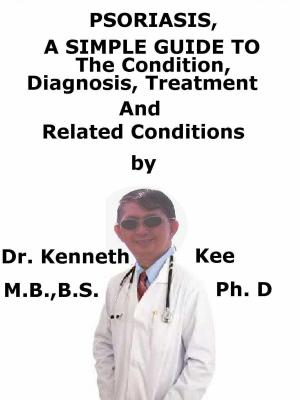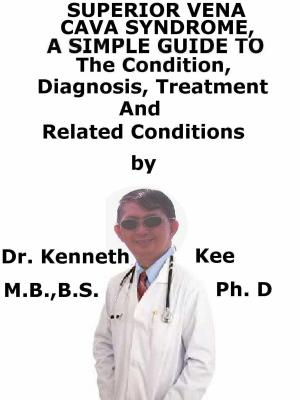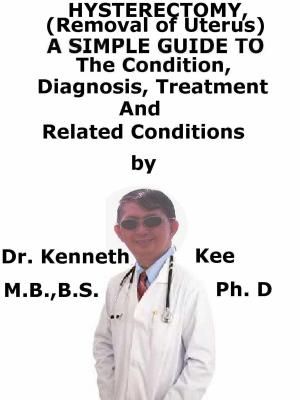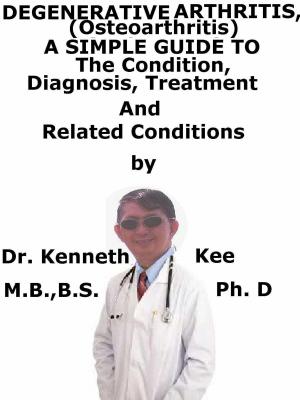Vitamin B3 Deficiency, A Simple Guide to the Condition, Its Treatment and Related Diseases
Nonfiction, Health & Well Being, Health, Nutrition & Diet, Vitamins, Medical, Patient Care, Nutrition| Author: | Kenneth Kee | ISBN: | 9781310584145 |
| Publisher: | Kenneth Kee | Publication: | December 5, 2014 |
| Imprint: | Smashwords Edition | Language: | English |
| Author: | Kenneth Kee |
| ISBN: | 9781310584145 |
| Publisher: | Kenneth Kee |
| Publication: | December 5, 2014 |
| Imprint: | Smashwords Edition |
| Language: | English |
Vitamin B3 is a water-soluble vitamin present in many foods.
Vitamin B3 is found in meat, poultry, vegetables and fruits
Vitamin B3 is important for heart function.
It is also important for brain function
Vitamin B3 Deficiency is a silent disease
Severity of Vitamin B3 deficiency is inversely related to age
One cause of Vitamin B3 deficiency is malabsorption
The other cause is poor food intake function
It is a cause of skin rashes and dermatitis
There is digestive problems and gastroenteritis
There may be brain dementia and mental confusion
In some cases there are psychotic manifestations
Prevention of Vitamin B3 Deficiency is as important as treatment.
Treatment of Vitamin B3 Deficiency is taking vitamin B3 supplements
And a diet containing red meat, egg yolks, fortified milk and liver,
Vegetable sources include whole grain cereals, orange and green vegetables
-An original poem by Kenneth Kee
Interesting Tips about the Vitamin B3 Deficiency
A Healthy Lifestyle
1. Take a well Balanced Diet
2. The goal of Vitamin B3 Deficiency treatment is the prevention of pellagra and heart failure.
Therefore prevention of Vitamin B3 Deficiency is as important as treatment.
Vitamin B3 Deficiency treatment and prevention measures are:
Medications:
Vitamin B3 is given in daily oral doses of 100 - 500 mg
It does not appear to be toxic in high dosage although diarrhea, digestive disturbances and water retention have been reported on dosage exceeding 10 g a day.
Taking 1,500 mg a day over an extended period may cause sensitivity to the teeth.
It is most effective when taken with the B group vitamins, Vitamin A, vitamin C and Vitamin E.
3. Keep bones and body strong
Bone marrow produces our blood
Eat foods rich in calcium like yogurt, cheese, milk, and dark green vegetables.
Eat foods rich in Vitamin D, like eggs, fatty fish, cereal, and fortified milk.
Eat food rich in Vitamins B and C such as green vegetables and fruits
Zinc and other minerals are important to the body
4. Get enough rest and Sleep
Avoid stress and tension
5. Exercise and stay active.
It is best to do weight-bearing exercise such as walking, jogging, stair climbing, dancing, or lifting weights for 2½ hours a week.
One way to do this is to be active 30 minutes a day at least 5 days a week.
Begin slowly especially if a person has not been active.
6. Do not drink more than 2 alcohol drinks a day for a man or 1 alcohol drink a day for a woman.
Alcohol use also increases the chance of falling and breaking a bone.
Alcohol can affect the neurons and brain cells.
7. Stop or do not begin smoking.
It also interferes with blood supply and healing.
Chapter 1
Vitamin B3
Vitamin B3 (niacin) plays an important role in the metabolism of the body’s nutrients.
It is essential for metabolism of fats, carbohydrates and protein to make fatty acids and cholesterol.
It also helps to fight allergies
It is essential for the maintenance of healthy skin, muscles and nerves.
Niacin is also used in the release of energy as well as the metabolism of fat, protein and carbohydrates.
It is used in the creation of lipids, neurotransmitters, sex hormones (estrogen, progesterone and testosterone) and hemoglobin.
Some are of the opinion that niacin is also helpful to fight wrinkles as well as graying of the hair.
Vitamin B3 is found primarily in
1. Animal sources - liver, chicken, beef, fish
2. Vegetable sources: Vitamin B3 is found in cereals, rice bran, wheat bran, peanut butter, nuts, ,barley, and rice.
It is rare as an isolated Vitamin B3 deficiency.
Introduction
Chapter 1 Vitamin B3 Deficiency
Chapter 2 Interesting Facts about Vitamin B3 Deficiency
Chapter 3 Treatment of Vitamin B3 Deficiency
Chapter 4 Pellagra
Chapter 5 High Cholesterol
Chapter 6 Dementia
Vitamin B3 is a water-soluble vitamin present in many foods.
Vitamin B3 is found in meat, poultry, vegetables and fruits
Vitamin B3 is important for heart function.
It is also important for brain function
Vitamin B3 Deficiency is a silent disease
Severity of Vitamin B3 deficiency is inversely related to age
One cause of Vitamin B3 deficiency is malabsorption
The other cause is poor food intake function
It is a cause of skin rashes and dermatitis
There is digestive problems and gastroenteritis
There may be brain dementia and mental confusion
In some cases there are psychotic manifestations
Prevention of Vitamin B3 Deficiency is as important as treatment.
Treatment of Vitamin B3 Deficiency is taking vitamin B3 supplements
And a diet containing red meat, egg yolks, fortified milk and liver,
Vegetable sources include whole grain cereals, orange and green vegetables
-An original poem by Kenneth Kee
Interesting Tips about the Vitamin B3 Deficiency
A Healthy Lifestyle
1. Take a well Balanced Diet
2. The goal of Vitamin B3 Deficiency treatment is the prevention of pellagra and heart failure.
Therefore prevention of Vitamin B3 Deficiency is as important as treatment.
Vitamin B3 Deficiency treatment and prevention measures are:
Medications:
Vitamin B3 is given in daily oral doses of 100 - 500 mg
It does not appear to be toxic in high dosage although diarrhea, digestive disturbances and water retention have been reported on dosage exceeding 10 g a day.
Taking 1,500 mg a day over an extended period may cause sensitivity to the teeth.
It is most effective when taken with the B group vitamins, Vitamin A, vitamin C and Vitamin E.
3. Keep bones and body strong
Bone marrow produces our blood
Eat foods rich in calcium like yogurt, cheese, milk, and dark green vegetables.
Eat foods rich in Vitamin D, like eggs, fatty fish, cereal, and fortified milk.
Eat food rich in Vitamins B and C such as green vegetables and fruits
Zinc and other minerals are important to the body
4. Get enough rest and Sleep
Avoid stress and tension
5. Exercise and stay active.
It is best to do weight-bearing exercise such as walking, jogging, stair climbing, dancing, or lifting weights for 2½ hours a week.
One way to do this is to be active 30 minutes a day at least 5 days a week.
Begin slowly especially if a person has not been active.
6. Do not drink more than 2 alcohol drinks a day for a man or 1 alcohol drink a day for a woman.
Alcohol use also increases the chance of falling and breaking a bone.
Alcohol can affect the neurons and brain cells.
7. Stop or do not begin smoking.
It also interferes with blood supply and healing.
Chapter 1
Vitamin B3
Vitamin B3 (niacin) plays an important role in the metabolism of the body’s nutrients.
It is essential for metabolism of fats, carbohydrates and protein to make fatty acids and cholesterol.
It also helps to fight allergies
It is essential for the maintenance of healthy skin, muscles and nerves.
Niacin is also used in the release of energy as well as the metabolism of fat, protein and carbohydrates.
It is used in the creation of lipids, neurotransmitters, sex hormones (estrogen, progesterone and testosterone) and hemoglobin.
Some are of the opinion that niacin is also helpful to fight wrinkles as well as graying of the hair.
Vitamin B3 is found primarily in
1. Animal sources - liver, chicken, beef, fish
2. Vegetable sources: Vitamin B3 is found in cereals, rice bran, wheat bran, peanut butter, nuts, ,barley, and rice.
It is rare as an isolated Vitamin B3 deficiency.
Introduction
Chapter 1 Vitamin B3 Deficiency
Chapter 2 Interesting Facts about Vitamin B3 Deficiency
Chapter 3 Treatment of Vitamin B3 Deficiency
Chapter 4 Pellagra
Chapter 5 High Cholesterol
Chapter 6 Dementia















